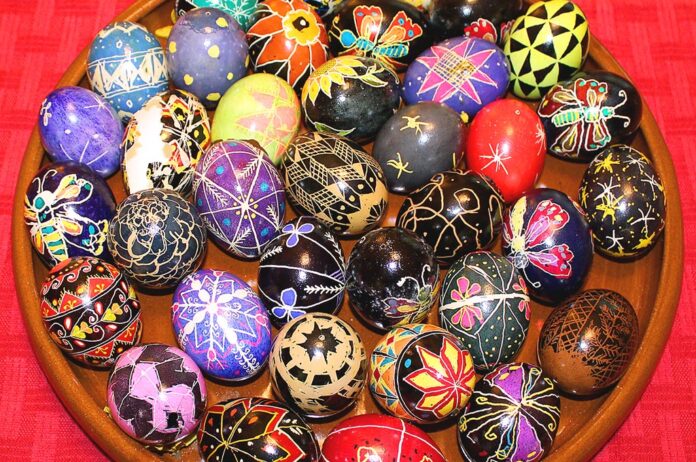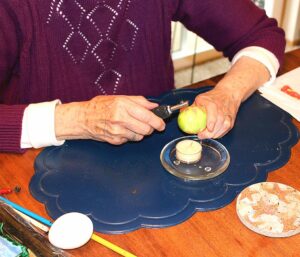
A weekend retreat got Marcia Sugg’s creative juices flowing and started her on a path of creating Ukrainian Easter eggs (called pysanky), an endeavor she enjoyed for many years afterwards. Pysanky refers to raw eggs decorated using a wax-resistance method.
“I was invited to a Catholic spiritual retreat by my Catholic friend in the 1990s,” Sugg said. “I in turn invited a third friend. She and I continued decorating eggs for a long time afterwards, and every year several of us would get together one Saturday before Easter and make more.

“Ukrainians traditionally use the symbols of nature for the eggs such as the Earth, land and water, and each color symbolizes something.”
The artist draws an initial design on the egg with a pencil and covers the lines with wax. After scraping some beeswax into the tiny “bucket” on the kistka, the artist holds it over a lighted candle to heat it and spreads the wax over the lines; the egg is then dipped in dye. “You don’t use Easter egg dye,” Sugg said.
The process is repeated with more lines and more wax, using progressively darker dyes, until the entire egg is covered in wax. (For those who want a shortcut, there are now electric kistkas.) After drying for several hours, the wax is carefully removed from the egg by heating it. Then the egg white and yolk are removed via a small hole, and finally the egg is covered with varnish.
Sugg, who was born in Ohio and raised in Michigan, spent most of her life in Lexington, Ky., after moving there to attend the University of Kentucky. After earning a degree in music education, she married and had two daughters. After a divorce, she married again and enjoyed 30 years of marriage before her husband died in 2013; meanwhile, her two daughters each had two daughters.
Over the years, Sugg started to lose the central vision in one eye and had lost a lot of her vision in the other eye by the early 2000s; she is now legally blind. “I couldn’t drive, and I was considered handicapped,” said Sugg, who nine years ago decided to move to Tigard to be close to one daughter and her family.
She can no longer create pysanky eggs but still enjoys the ones she has made, which hold special memories.
“I read that in Ukraine, when you are making an egg, you think of the person you are making it for,” Sugg said. “When you give an egg, you are giving love, hope and prosperity. My heart breaks and aches for the women over there who can’t do this anymore.”





















